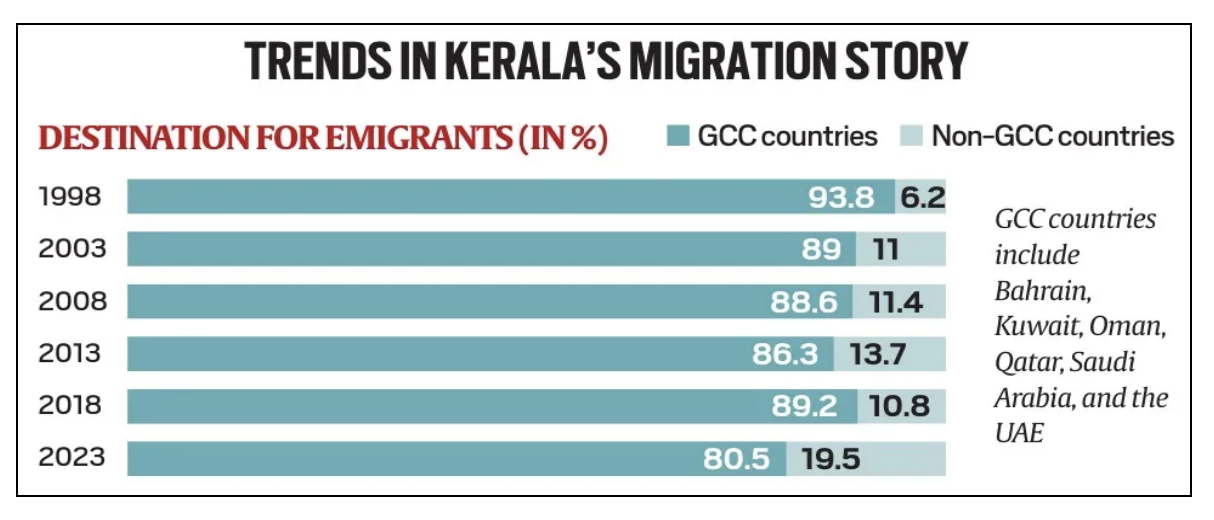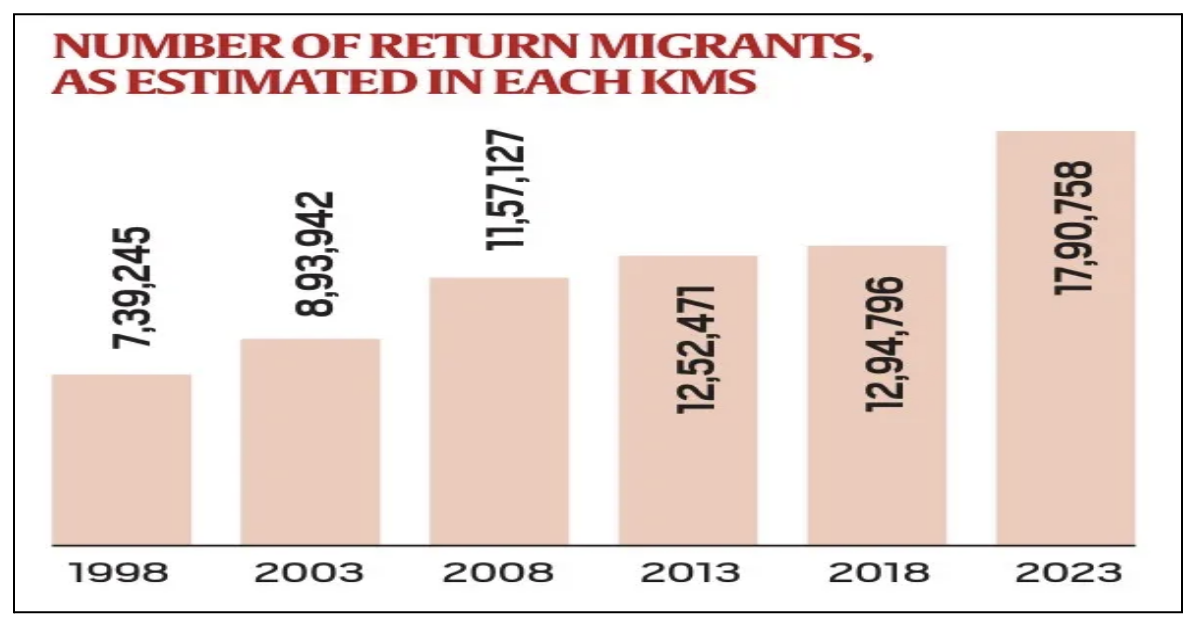News Excerpt:
The Kerala Migration Survey (KMS) 2023 report, unveiled at the Lok Kerala Sabha in Thiruvananthapuram, offers an in-depth analysis of migration patterns in the state.
More about the report:
- Conducted by the International Institute of Migration and Development (IIMD) and the Gulati Institute of Finance and Taxation.
- This is the sixth edition of KMS, conducted every five years since 1998, surveyed 20,000 households across Kerala’s 14 districts.
Survey Methodology
- The survey adopted a stratified multi-stage random sampling method, distinguishing rural and urban areas within districts as separate strata.
- Localities (Gram Panchayats or Municipal Wards) were selected based on household numbers within these strata, resulting in 500 localities statewide.
- In each locality, 40 households were chosen using systematic random sampling, culminating in a substantial sample size of 20,000 households.
- This makes KMS one of the most extensive socio-economic surveys in Kerala, surpassing the National Family Health Survey (NFHS-5) which sampled 12,330 households.
- Digital Data Collection
- For the first time, the survey utilized digital tools for data collection, deploying 300 trained investigators.
Key Findings:The survey estimates 2.2 million emigrants from Kerala in 2023, a slight increase from 2.1 million in 2018.
- Decline in Gulf Emigration: There's a notable decline in migration to Gulf Cooperation Council (GCC) countries, with preference for destinations beyond the GCC rising from 10.8% in 2018 to 19.5% in 2023.
- This continues the trend observed since 1998 when 93.8% of emigrants favored GCC destinations.

- Rising Student Emigration: Student emigration has surged, with their numbers almost doubling from 129,763 in 2018 to 250,000 in 2023.
- Students now constitute 11.3% of total emigrants, and they generally prefer non-GCC countries for higher education.
- Increasing Female Emigration: Women emigrants have increased from 15.8% in 2018 to 19.1% in 2023.
-
- They tend to be better qualified, with 71.5% holding degrees compared to 34.7% of men.
-
- Women dominate the nursing sector, making up 51.6% of workers, and account for 45.6% of student migrants.
-
- Additionally, 40.5% of women emigrants are in Western countries, compared to 14.6% of men.
- Regional and Demographic Insights:
-
- North Kerala: Leads in emigration, especially to GCC countries, with 41.8% of emigrants.
- Central Kerala: Accounts for 33.1% of emigrants, showing a higher tendency towards non-GCC destinations.
- South Kerala: Contributes 25% of emigrants.
- Religious Demographics: Muslims (26% of Kerala’s population) form 41.9% of emigrants, Hindus (54% of the population) make up 35.2%, and Christians (18% of the population) constitute 22.3%.
- Economic Impact and Return Migration:
- Total remittances to Kerala soared to Rs 216,893 crores in 2023, a 154.9% increase from 2018, translating to Rs 61,118 per capita.
- The average remittance per emigrant household rose to Rs 2.24 lakh.
- The number of returnees has also increased significantly, with 1.8 million returning home by 2023, up from 1.2 million in 2018.
- COVID-19-induced job losses were a major factor, alongside low wages, poor working conditions, illness, and a desire to work in Kerala.

Long-Term Trends and Future Directions:
- Since the first KMS in 1998, the number of emigrants has fluctuated, peaking at 2.4 million in 2013 before declining to 2.1 million in 2018.
- The global Malayali diaspora is estimated at 5 million, with an additional 3 million Malayalis residing outside Kerala but within India.
Way Forward :
- The rise in student migration highlights the need for enhanced educational infrastructure in Kerala.
- Ensuring safe migration pathways, and regulating language training centers, and recruitment agencies can reduce fraud and exploitation.
- Policies encouraging the return of skilled students could foster a beneficial "brain gain."
- For labor emigrants, comprising 76.9% of the emigrant population, improving skill sets is crucial for securing better opportunities abroad, particularly in Western countries.
- The growing number of returnees also highlights the necessity for comprehensive rehabilitation and reintegration measures.
Conclusion:
The KMS 2023 provides critical insights into Kerala’s migration trends, highlighting shifts in destinations, the rise of student and female emigrants, and the economic impact of remittances. Addressing these trends with targeted policies can enhance the benefits of migration for both individuals and the state.


